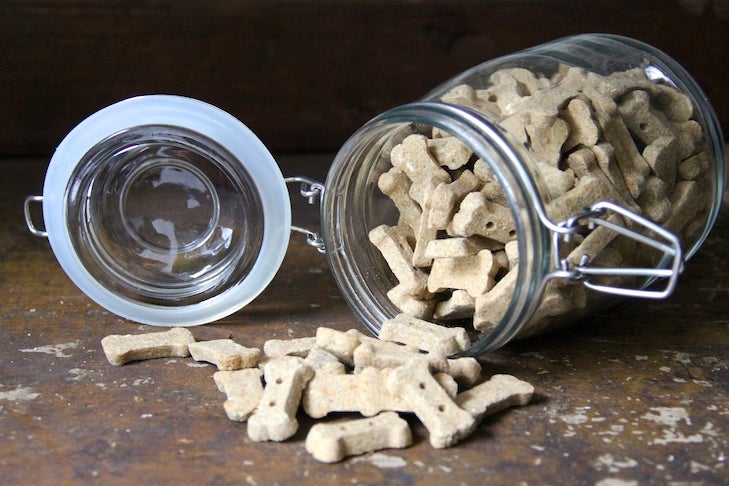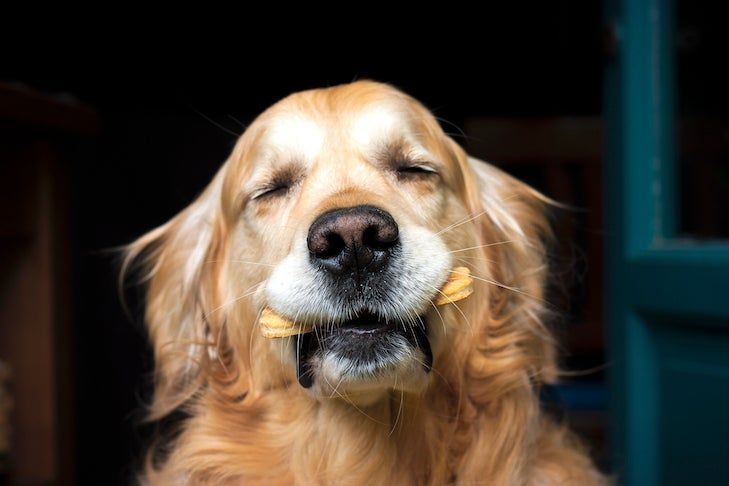Health Benefits of Puppy Eating Sticks
Just as humans, puppies need proper dental care to maintain oral health. Veterinarians recommend that you brush your puppy’s teeth at least 3 times a week. This may sound excessive but brushing 3 times a week prevents plaque and tartar buildup.
Every time your puppy eats, food particles get stuck between their teeth. When these food particles mix with saliva, they start forming plaque. Plaque can be prevented and removed by regular brushing. When the plaque is left untreated, it can result in tartar buildup which will require professional assistance, and in some cases, may require administration of anesthesia. Severe tartar buildup can result in dental diseases which can then lead to other health risks.
Even if you get into a routine of brushing your puppy’s teeth 3x a week, there may still be plaque buildup. Because plaque can form within 24 hours of eating. The best way to avoid these oral problems is by giving your little one dental sticks specifically made for puppies. You see, puppy eating sticks provide many oral benefits including:
Improving Gum and Teeth Health: When your puppy chews on puppy dental sticks, the constant scraping of the teeth and gum against the hard surface helps remove any plaque and tartar buildup. After you brush your puppy’s teeth, give him/her puppy dental sticks to ensure there is no plaque and tartar buildup in between dental cleaning sessions.
Promoting Fresh Breath: It’s not unusual for puppy breath to smell slightly unpleasant. However, if they have bacteria buildup, or plaque and tartar buildup, their breath will often have a foul odor which can be a sign of dental disease. The first thing you should do is check with your vet to rule out any possibilities of dental diseases. If your puppy’s dental health is perfectly fine, puppy dental sticks can help reduce bad breath and freshen breath so you can enjoy the endless puppy smooches.
Clubs Offering:
As a dog owner, I frequently come across the 10 percent rule. It sounds simple. “Treats should not make up more than 10 percent of your dog’s diet,” say veterinarians everywhere.
I’ve quoted this so many times I’ve lost count, but then, as I was in the middle of a training session with my dog, treat bag full of tiny treats, I had a crisis of faith.
What does 10 percent of a dog’s daily diet actually mean?
It is easy to make general assumptions about quantity.
When it comes down to calculating 10 percent, I realized I did not know exactly how to do it.
The answer is in the calories, much like many human dietary plans. Unlike humans, however, the sheer range in size between dogs means that you can’t fall back on a solid number, like the 2,000 daily calories most human nutritional labels use. This means you will have to come up with that number yourself.
Your dog’s food bag should tell you the number of calories in your dog’s food, (based on your dog’s weight) but as you check it, you may notice that the caloric content is measured in kcals, not the same calories you are used to seeing. This is often confusing.
Scientifically speaking, a kcal is a kilocalorie, or 1,000 calories. Dog food manufacturers, however, must have figured out that “kcal” doesn’t roll off the tongue the same way “calories” does, because the calories found on food packages are actually kcals.
In other words, when your dog’s food says: 364 kcal/cup, as is the case with Hills Science Diet Active Longevity, it just means 364 calories per cup. Normally, 364/kcal would be equivalent to 364,000 calories, but in this case, “kcal” and “calories” are used interchangeably.
If your dog’s food does not tell you the number of calories per cup, you have to do a little more research, like calling the company and asking your veterinarian what your dog’s total daily caloric intake should be.

Now that we’ve cleared that up, let’s get down to the math. Figuring out 10 percent of your dog’s daily diet requires first figuring out how many calories your dog consumes each day.
According to the package feeding instructions, let’s say I feed a senior German Shepherd Dog four cups of Hills Active Longevity a day and my veterinarian approves of her weight. That’s 1,456 calories a day.
Ten percent of 1,456 is 145.6, which gives me, at last, a number.
Unfortunately, I still had questions. Was this the number of calories I could feed on top of my dog’s four cups of food, or did I have to adjust her food to make up for these calories?
The answer, according to veterinarians, requires a little more math.
While the best resource for calculating the amount of treat calories you can feed your dog is your veterinarian, in general, most of the veterinary articles I read suggested that treats should not make up more than 10 percent of your dog’s total diet, and that diet includes treats and snacks.
In other words, if you feed a lot of high-calorie treats, you need to subtract a few kibbles to make up the difference. Subtract too many dog food kibbles, however, and you will be depriving your dog of necessary nutrients. That would be like calculating the number of calories in ice cream and deciding to cut out fruits, vegetables, and protein calories to make up for it.
You should also keep in mind that your dog’s total caloric requirements might not reflect the feeding guidelines of your dog’s food bag. My veterinarian, for instance, recommended feeding more than was advised by the food company to one of my dogs and significantly less to my other dog. For the most accurate estimate, talk to your veterinarian about your dog’s nutritional and caloric needs.

Now let’s talk about cheese. Note that cheese may not be the best treat for all dogs due to its high-calorie content, however, it makes a good example here.
One cube (one cubic inch) of cheddar cheese contains about 69 calories. That is about 5 percent of an 80-pound German Shepherd’s daily intake. If fed sparingly, this is not necessarily a problem, but what about your 5-pound Yorkshire Terrier? What would a single cube of cheese do to him?
If your 5-pound Yorkie needs one-half cup of Hills Active Longevity a day, that is only a total of 182 calories. Ten percent of his diet is 18 calories. That one cube of cheese is nearly four times the amount of recommended calories –- about the same as eating a Big Mac for us.
On the other hand, one-half cup of sliced cucumbers contains only 8 calories, and one medium-sized carrot contains only 25 calories. You can also consider using cooked asparagus and cooked green beans as low-calorie treats.
Looking at a cube of cheese is a great way to visualize why low-calorie treats are healthier options for your dog. If vegetables don’t get your dog motivated, you can always look for a meat-flavored training treat with a low caloric content, or use your dog’s food and just subtract what you feed as a treat from his total diet.
Even if you don’t count calories for your own diet, it is a good idea to be aware of the caloric content of the human foods or dog treats you might be tempted to feed your dog.
Obesity leads to canine health problems, such as joint disease, diabetes, and pancreatitis; we can lessen the likelihood of these problems occurring if we limit our dog’s food intake.
It is also hard to adjust our thought process down to scale. For instance, I was very surprised to realize how many calories a single cube of cheese could add to a small dog’s diet. Things that we might not think of as adding excessive calories, like cheese, hot dogs, rawhide chews, or scraps of meat can cause big problems over time.
The good news, however, is that by doing a little math, you, too, can estimate the maximum number of treat calories your dog should have each day and learn how to adjust his diet accordingly.
If your dog is already overweight, talk to your veterinarian about the best weight loss plan for your dog, and the type and amount of treats that will be best suited to her needs.
What chew sticks are good for puppies?
Bully sticks are “fully digestible, and chewing them is good for the teeth and gums,” says Klein. And while they’re definitely softer than bone, they’re still tough enough to last a long time.
11 Reasons Why Dogs Love Chewing On Sticks
Whether you’re new to puppy parenting or know what to expect, you’re probably aware of how much puppies love to chew. Shoes, clothes, hand bags, furniture—you name it—in those first few months of teething, nothing seems to be off-limits. During this time, setting chewing boundaries for your pup can be a near-constant battle.
Despite testing your patience, you probably also know that a puppy’s need to chew is perfectly natural and instinctual. In addition to relieving the pain and discomfort of teething, chewing helps support a healthy mental state by releasing two important neurotransmitters; dopamine and serotonin, aids in combating boredom, and strengthens their jaw muscles.
Bully sticks are one of the best chew treats you can give your puppy to help satisfy their need to munch, crunch and gnaw on things to death!